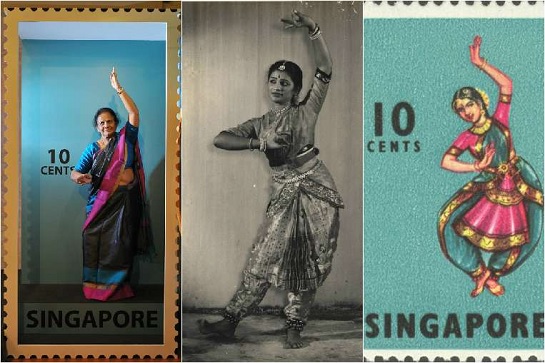By Lim Yi Han

It looked like just another e-mail sent to Bhaskar’s Arts Academy asking for a dancer to perform an Indian dance routine at the launch of an exhibition.But when the academy’s artistic director and choreographer, Mrs Santha Bhaskar, read the e-mail from the Singapore Philatelic Museum, she had a pleasant surprise.The e-mail sent in June had requested the performer to don a costume in the same colours as the dancer in a 1968 stamp that would be featured in the exhibition.As it turned out, Mrs Bhaskar, 75, was the dancer in the stamp, which was issued then to promote racial harmony.
“I never thought that it’s going to come back now. Even when they asked for a dance item, I thought it was simply for an exhibition, and didn’t think my stamp would be on display,” she told The Straits Times.”I’m very surprised. Even now, I still can’t believe it. My grandchildren have no idea that there was a stamp with their grandmother.”
The stamp is now being shown at the exhibition titled The Singapore Journey: 50 Years Through Stamps, which was launched two weeks ago. It features stamps and related items showing Singapore’s progress through the years, to celebrate the nation’s Golden Jubilee.
Mrs Bhaskar said: “I’ve lost the stamps over the years, so to see it in public now, I’m very happy and honoured.”A Cultural Medallion recipient for dance, Mrs Bhaskar was born in Kerala, India, and came to Singapore in 1955 after an arranged marriage with Mr K.P. Bhaskar, founder of Bhaskar’s Arts Academy.
She became a Singapore citizen in 1960, and the couple have three children and four grandchildren. Mr Bhaskar died two years ago from a heart-related illness.
How did Mrs Bhaskar become the model for a stamp?:In 1968, Mr Bala Subramanion, Singapore’s first Postmaster General, had asked Mr Bhaskar for a picture of an Indian dancer for use in a series of stamps titled Masks and Dances Definitives, which depicted the traditional performance arts of the Chinese, Indians and Malays.
Mr Bhaskar gave him a picture of his wife. Mr Subramanion, now 98, said: “Singapore experienced its most serious race riots in July and September of 1964, shortly after joining Malaysia. It is no wonder that racial harmony is a priority for Singapore.” He had contacted Bhaskar’s Arts Academy, as it was a “pioneer in Indian dance”.
For Mrs Bhaskar, it was a proud moment. “I used them to send letters to our family and relatives in India,” she said.
She added that stamps had more impact then because people used to write letters to each other more often, unlike now, when messages are sent using technology.
The 1968 series of stamps also proved that the arts was flourishing in Singapore in the 1960s.
“It didn’t just promote racial harmony. People thought that at that time, Singapore didn’t have any art, it was a cultural desert. But it’s not true. The only thing was that there was no funding available, but there was art, theatre, music, dance.”
Indian dance is still relevant today, she said. “In any art form, you find your roots. You’d know where your grandparents came from.”
While Mrs Bhaskar turns 76 in October, she still maintains an active lifestyle by conducting classes at least once a week at Bhaskar’s Arts Academy and at the National University of Singapore’s Centre For the Arts. She also does yoga.
“I don’t think about my age so I’m as normal and energetic as I can be, still exploring things,” she said.(Source- The Straits Times)
